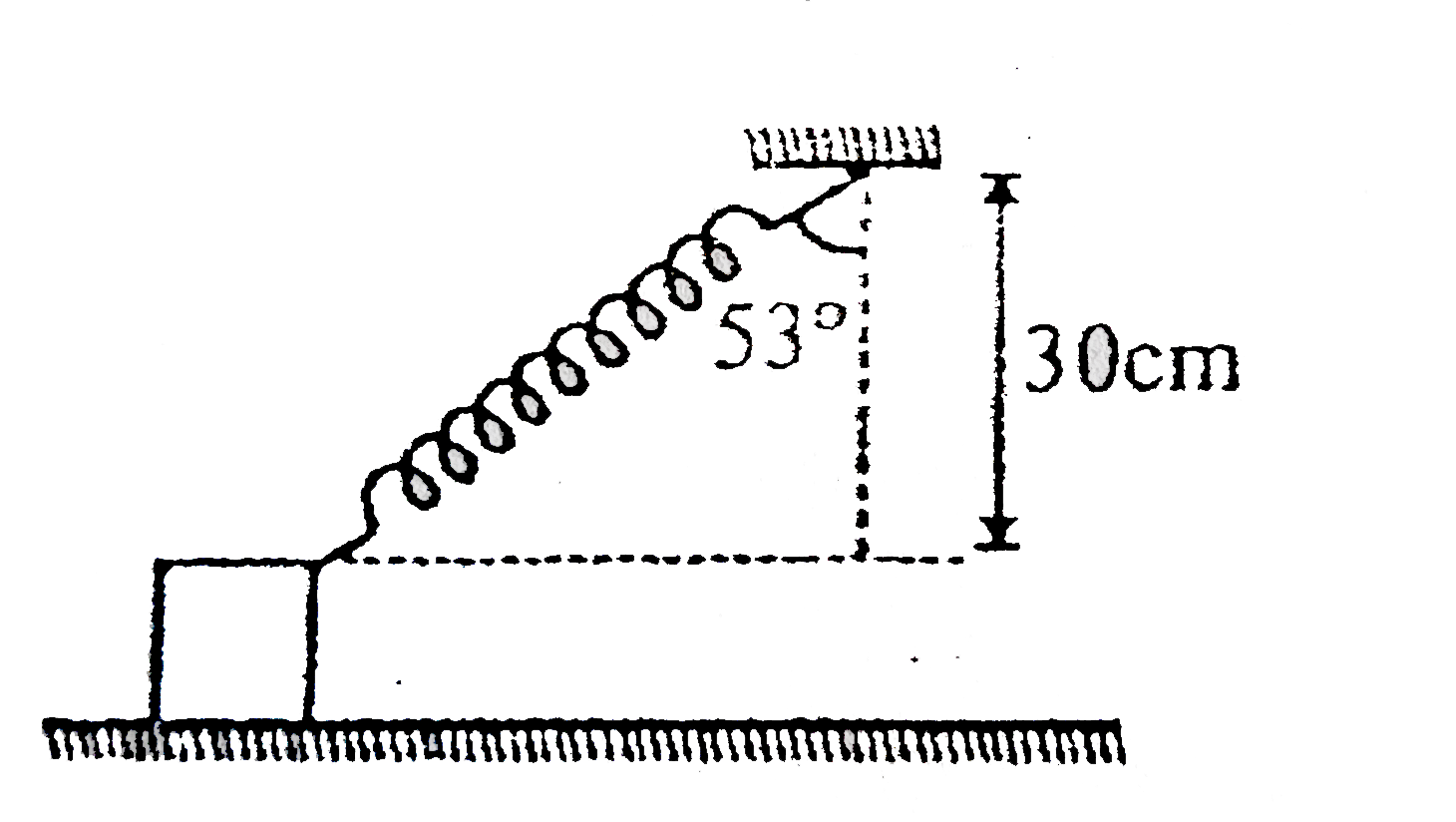A block of mass m is suspended by a rubber cord of natural length l=mgk, where k is force constant of the cord. The block is lifted upwards so that the cord becomes just tight and then block is released suddently. Which of the following will not be true?
Block performs periodic motion with amplitude greater than l.
Block performs SHM with amplitude equal to l.
Blocks will never return to the position from where it was released.
Angular frequency ω is equal to 1rads
The correct Answer is:A, C, D
When the block is released suddenly, it starts to move down. During its downwards motion the rubber coed elongates. Hece, a tension is developed in it but the blocks continues to accelerate downwards till tension becomes equal to weight mg of the block. After this moment, the block continues to move down due to its velocity and rubber cord further elongates. Therefore tension becomes greater than the weight, hence, the block now retards and comes to an instantaneous rest. At lowest position of the block, strain energy in the cord equals loss of potential energy of the block. Suppose the block comes to an instantaneous rest when elongation of the rubber cord is equl to y. Then
12ky2=mgy⇒y=2mgk and 0
Hence block will be instantaneously at rest, at y=0 and at y=2mgk. If fact, the block oscillates between these two values. Since the rubber cord is elastic, tension in it is directily proportional to elongation therefore, the block will perform SHM. Its amplitude will be equal to half of the distance between these extreme positions of the block or amplitude is
12×2mgk=mgk=l
Hence option (b) is correct.
The angular frequency of its SHM will be equal to
ω=√km
Since k and m are not given in the question, it cannot be calculated. Hence option (d) is not correct.
Topper's Solved these Questions
- LINEAR AND ANGULAR SIMPLE HARMONIC MOTIONBook:CENGAGE PHYSICSChapter:LINEAR AND ANGULAR SIMPLE HARMONIC MOTIONExercise:Assertion Reasoning
Explore 6 Videos
- LINEAR AND ANGULAR SIMPLE HARMONIC MOTIONBook:CENGAGE PHYSICSChapter:LINEAR AND ANGULAR SIMPLE HARMONIC MOTIONExercise:Comprehension
Explore 33 Videos
- LINEAR AND ANGULAR SIMPLE HARMONIC MOTIONBook:CENGAGE PHYSICSChapter:LINEAR AND ANGULAR SIMPLE HARMONIC MOTIONExercise:Single Correct
Explore 107 Videos
- KINETIC THEORY OF GASES AND FIRST LAW OF THERMODYNAMICSBook:CENGAGE PHYSICSChapter:KINETIC THEORY OF GASES AND FIRST LAW OF THERMODYNAMICSExercise:Interger
Explore 11 Videos
- MISCELLANEOUS KINEMATICSBook:CENGAGE PHYSICSChapter:MISCELLANEOUS KINEMATICSExercise:Interger type
Explore 3 Videos
Similar Questions
A block of mass M is kept on a rough horizontal surface and is attached with massless spring of force constant k .The minimum constant force applied on the other end of the spring to lift the block is
View SolutionA block of mass m suspended from a spring of spring constant k. Find the amplitude of S.H.M.
View Solution
Knowledge Check
When a block of mass M is suspended by a long wire of length L, the length of the wire becomes (L+l). The elastic potential energy stored in the extended wire is
A12MgLBMglCMgLD12MglA block B of mass M is suspended from a cord of length l attached to a cart A of mass M as shown in the figure. The horizontal surface on which the cart moves is smooth. Initially both the cart and the block are at rest in the position shown. Now B is released. Take M=m=2kg,θ=45∘andg=10m/s2.

The tension in the cord immediately after the system is released from rest isA10 NB103NC5√32ND20√23NWhen a block of mass M is suspended by a long wire of length L, the length of the wire becomes (L+l). The elastic potential energy stored in the extended wire is
AMglBMgLC12MglD12MgL
Block of mass 2m is given v0 towards the right. If L is the natural length of spring constant k, find the maximum elongation of the spring.

View SolutionA block B of mass M is suspended from a cord of length l attached to a cart A of mass M as shown in the figure. The horizontal surface on which the cart moves is smooth. Initially both the cart and the block are at rest in the position shown. Now B is released. Take M=m=2kg,θ=45∘andg=10m/s2.

The magnitude of acceleration of B (with respect to cart) immediately after the system is released from rest is
View SolutionA block B of mass M is suspended from a cord of length l attached to a cart A of mass M as shown in the figure. The horizontal surface on which the cart moves is smooth. Initially both the cart and the block are at rest in the position shown. Now B is released. Take M=m=2kg,θ=45∘andg=10m/s2.

The acceleration of the cart immediately after the system is released from rest is
View SolutionA block of mass 2kg is connected with a spring of natural length 40cm of force constant K=200N/m. The cofficient of friction is μ=0.5. When released from the given position, acceleration of block will be

View SolutionA block of mass m is suspended from a fixed support with the help of a cord. Another identical cord is attached to the bottom of the block. Which of the following statement is/are true?
View Solution

